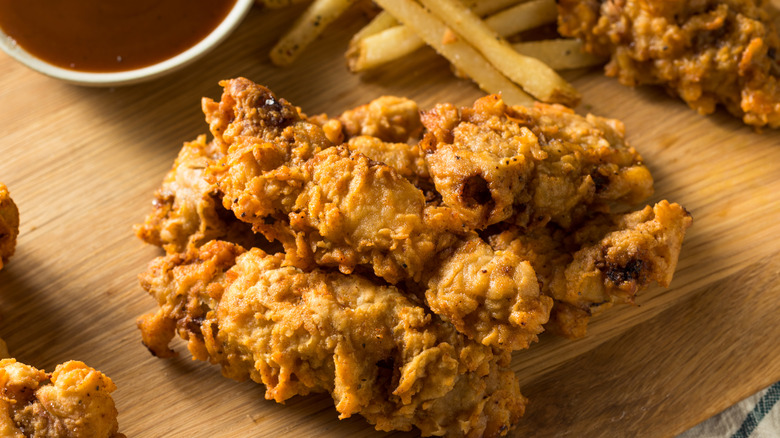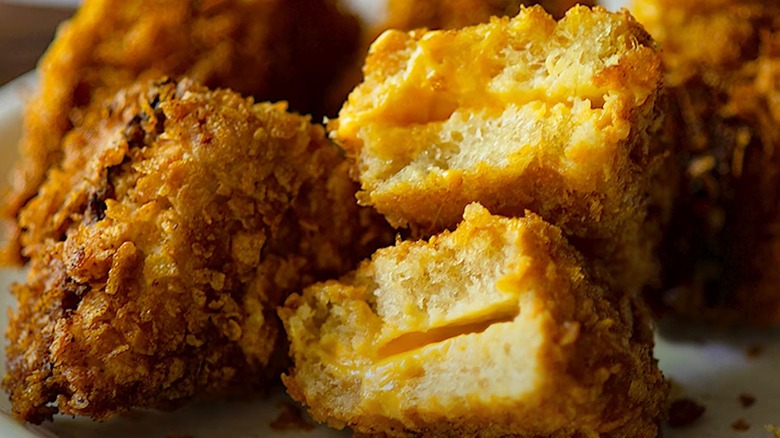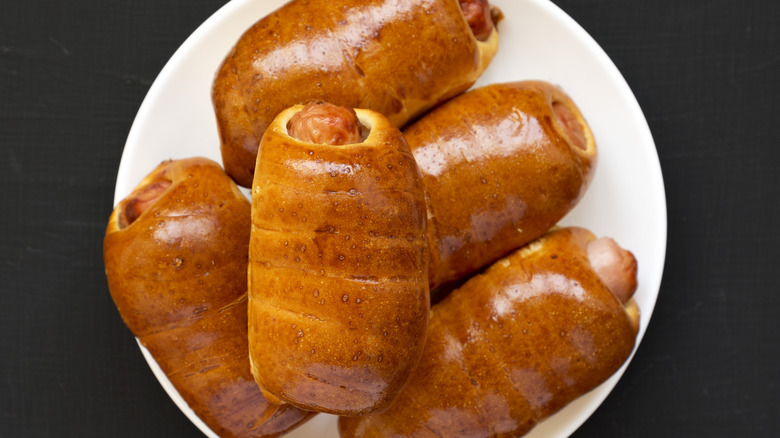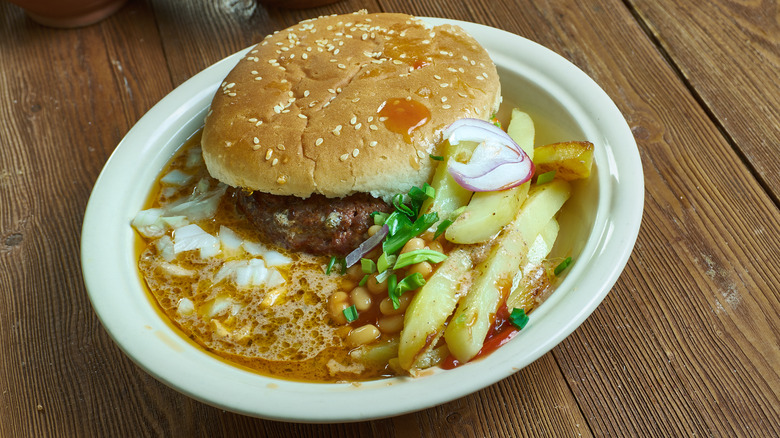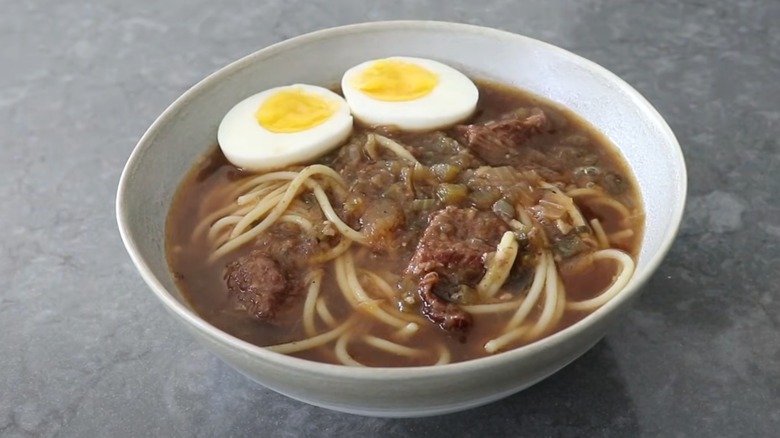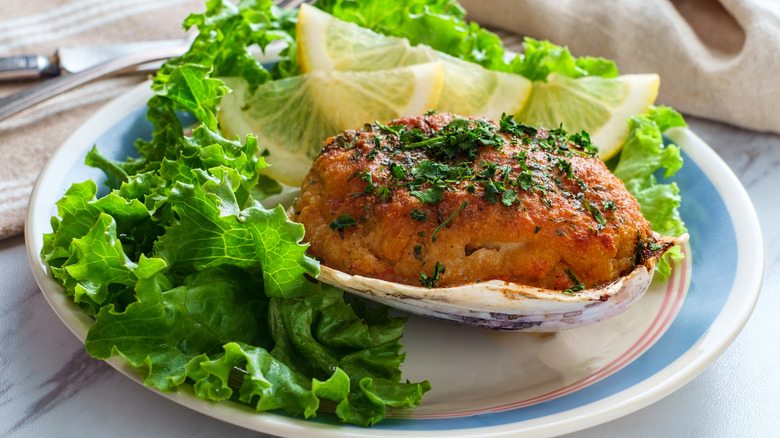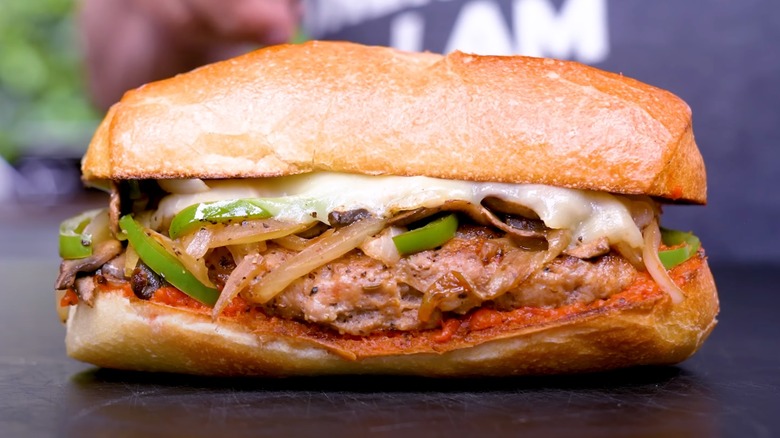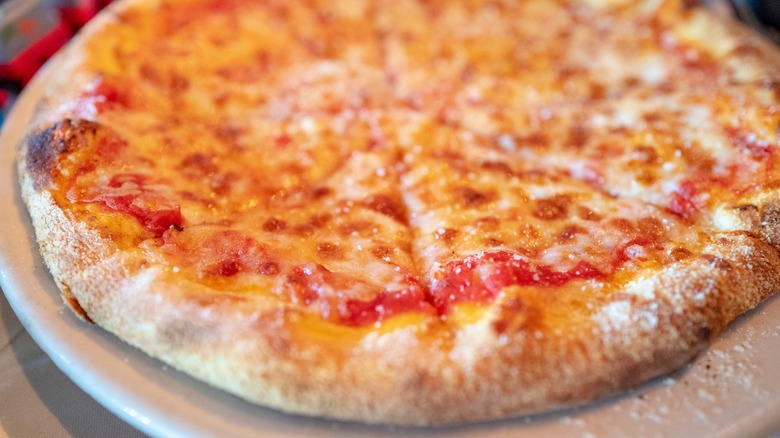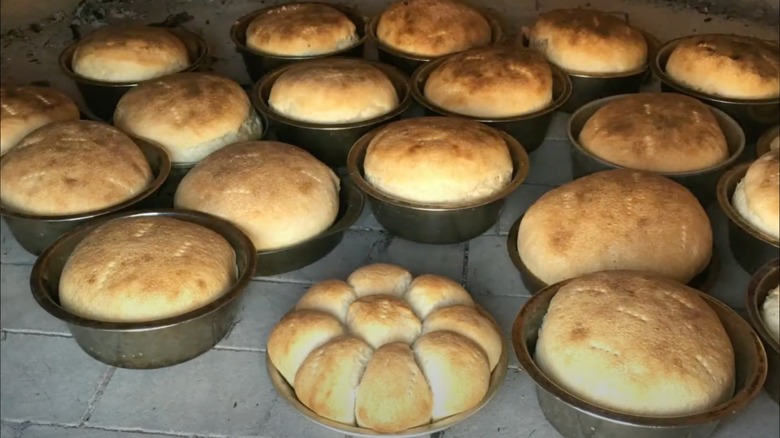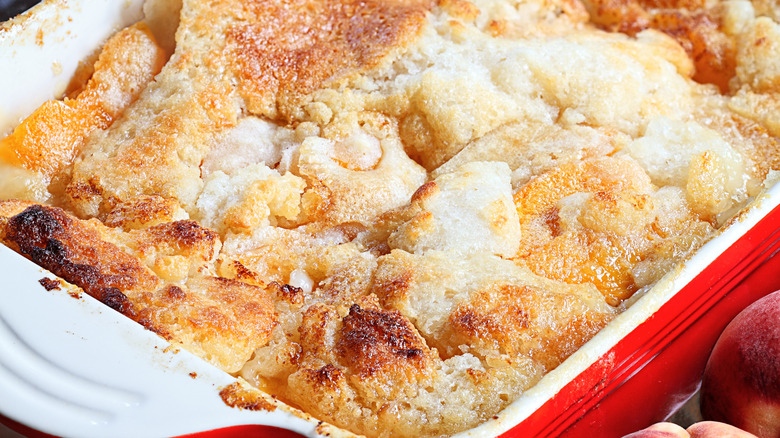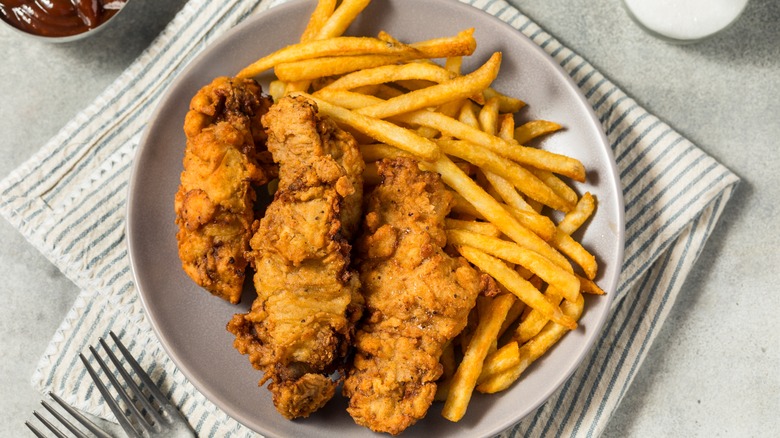Unique Regional Dishes That Deserve National Fame
The United States is a big place, and there's a lot of food in it. Like most countries in the world, the culinary landscape of the U.S. has a lot of common threads, but also a great deal of regional diversity. Each area's food culture is defined by the communities that you can find there, the influences that individual people and groups alike bring to the table, and the ingredients that are readily available locally. As a result, there are a lot of different dishes across the country, with plenty that you probably haven't heard of. Well, we think it's time to bring them to the world.
Delicacies like cheese frenchees, yakamein, sonker, and pueblo bread may be unfamiliar to you, but we know you're going to love them. Others, like mashed potato pizza, are things that you can replicate in your very own home (and hey, it's a great way to use up leftover mash). If you can't afford to take that trip across America that you've always dreamed of, you can do the next best thing by reading about these unique regional dishes from the comfort of your own home. Just don't blame us if it makes you a little hungry.
Cheese Frenchee
Deep-fried cheese sandwiches? They're a thing, at least if you're in Nebraska. The landlocked Midwestern state boasts the cheese frenchee as one of its homegrown delicacies, and it can be traced back to the 1950s. Now considered a quintessentially Midwestern food, this sandwich was first pioneered by King's Food Host, a Lincoln-based restaurant that made the cheese frenchee its most famous export over the course of several decades. Other restaurants and chains soon caught on, and nowadays the frenchee is on the menu across the whole state.
It's not just cheese that you can put in these sandwiches, either. Tuna frenchees, hot dog frenchees, and pizza frenchees are all available in various restaurants, giving the already hefty sandwich even more bite and flavor. As for that crunchy exterior on the frenchee, it's usually studded with either crushed-up cornflakes or graham crackers, giving it a delightful texture that contrasts its soft interior. The cheese, meanwhile, is best kept simple, with American or Cheddar tending to be the choice of most restaurants. Look, this isn't a health food by any means, but it's a uniquely Nebraskan experience.
Kolaches
The food scene in Texas is traditionally associated with steaks, fries, and burgers. However, there's a lot more nuance to it than most people give it credit for, and a wide variety of regional and international influences that create diversity in the state's culinary galaxy. Proof of this comes in the form of kolaches, small pastries filled with cheese, fruit, or meat, and served in the state's countless bakeries, often as a breakfast item. "Anyone that has spent time in Texas and been exposed to kolaches has fallen in love," says cookbook author Lisa Fain to Epicurious. We find it pretty amazing that they haven't blown up in other parts of the country, to be honest.
Kolaches are Czech in origin, and were originally brought to the state by migrants who began making koláč (a type of circular pastry) and selling them in stores and eateries. Soon, recipes for kolaches began being developed by other people in the state, with new fillings being incorporated into the mix. Some restaurants have taken things to extravagant levels, making their pastries with fillings like curry or brisket. You'll struggle to find these elsewhere in the country, unless you're in an area with a significant Czech presence — and even then, they probably won't have the wild and wacky fillings that Texans love.
The Slopper
If you're looking for a dish with a disgusting-sounding name that tastes absolutely incredible, then we present to you the slopper. This dish can be found in Pueblo, Colorado, as well as its surrounding areas. Most of the rest of the country has never heard of it, but we wish they had, as this burger-enchilada hybrid is pretty delish. The slopper has the base of a standard cheeseburger, but instead of being crowned with a second bun, it's smothered in green chile sauce. The towering construction is then covered in avocado, pico de gallo, and sour cream.
There's no denying that this dish is definitely sloppy, and it's pretty hard to eat like a regular sandwich. Those who persevere, though, will be rewarded with an explosive medley of flavors. The story of the slopper dates back to the 1950s, when it was apparently invented when a customer asked for a burger topped with chili; other tales say that it was first created in the 1970s through the very same sequence of events. Regardless of how it came about, it's never quite taken off nationally. We think it's time that changed, though.
Yakamein
There's chow mein, there's lo mein, and now there's yakamein too. This Cajun-flavored noodle soup is a comfort food staple in New Orleans, particularly amongst African American communities, and its appeal lies in the speed with which it can be made. Legend has it that yakamein was first invented in the 1800s, when Chinese laborers arrived in New Orleans to work on constructing railroads, bringing their food culture with them. Others say that it was pioneered by, and for, African American soldiers who had been placed abroad and sought to replicate the flavors that they enjoyed while in Asia. Regardless of how it started, though, yakamein is here to stay — but you won't find it elsewhere in the country, at least under that name.
The dish is also known as "old sober," and we can understand why. Given its soothing, warming properties, it's the perfect dish for when you have a sore head after a night of frivolity. It also goes by a host of different spellings for yakamein, including yet-ca-mein, ya-ka-meat, and yakimi. Perhaps the reason why this dish has remained a local curiosity for so long is that there doesn't seem to be a standard recipe for it. Instead, it's one of those dishes that's passed down from person to person, from family member to family member, with every individual having their own spin on it.
Stuffies
Want to eat like they do in Rhode Island? You've got to try stuffies. The humble stuffie is a Northeastern delicacy made from a stuffed quahog clam, seafood commonly found around the shoreline of the state. While stuffies have a few common threads in the recipes you'll find dotted around the region, the specifics vary slightly from chef to chef, making this dish delightfully diverse and dynamic. Some things are always the same, though — these clams are baked in an oven and served on the shell, giving them a visual pop.
While baked clams have been served around the world for hundreds of years, Rhode Island stuffies can be traced back to the early 1900s. They were originally filled with bread, and as a result, they took on a reputation as being food for folks who couldn't afford better (which was added to by the fact that clams were looked down upon as a frugal choice). Over time, though, stuffies became a touch classier, aided by the boom in popularity for stuffed clams created by dishes like clams casino. These days, you can find stuffed clams in a lot of restaurants around the country — but there's only one place to find stuffies.
Cudighi
Just because a food is popular in one specific region in the United States, doesn't mean that it necessarily originated there, as proven by cudighi. These days, cudighi is a Michigan delicacy, found pretty much exclusively in the Upper Peninsula region of the state. However, it developed from more traditional Italian sausage recipes, brought to the area by Italian miners working around Lake Superior.
Everything changed when one particular Italian migrant opened a sausage stand in the area, and started creating his own sausage meat spiced with unique flavors. At first, he kept the recipe of the sausage (then known as gudighi) a secret, but folks started figuring out the taste and making their own versions. Soon, cudighi was sold all across the state, primarily in sandwich form. As for the flavor of cudighi, it's a heady, heavily spiced affair, with cloves, cinnamon, allspice, nutmeg, and garlic all taking center stage. The pork sausage is also heavily scented with red wine, although fennel, that standard ingredient in sausagemeat, is nowhere to be seen. A touch of spice comes from the red pepper flakes in the recipe. Trust us when we say that it's worth traveling for.
Mashed potato pizza
We love the kitchen. It's a room where some of the best experiments known to humankind have been conducted, resulting in some utterly wild food mash-ups that taste completely delicious — but, for some reason, often don't travel far from the sight of their invention. There are plenty of examples of this in America, but mashed potato pizza has to be one of our favorites. To try an authentic version of this dish, you'll have to travel to Connecticut, and more specifically to New Haven, where it's become an underground delicacy enjoyed by those in the know.
The idea of putting mashed potatoes on pizza may seem unusual at first, but it's especially popular amongst the younger residents of the city, and it's easy to see why: It has all of the comforting flavors of childhood in one bite. Although it might sound stodgy, the mashed potato pizza is actually fairly well-considered. Chefs prepare an aerated mashed potato, which keeps the butter light, so that things don't get too overwhelming or rich. The dough, meanwhile, is intentionally thin and crispy. It's the kind of pizza that really hits the spot after a couple of beers, but won't totally send you into a carb-induced slumber. Well, depending on how much you eat.
Pueblo bread
Although plenty of unique regional dishes have stemmed from some chefs getting brave in the kitchen, others are born from old traditions and hold deep cultural significance. Pueblo bread is one of these. This little-known bread is a staple of New Mexico's Native Pueblo peoples, and is a living embodiment of colonial influences mixed with traditional cooking methods. Pueblo bread is made with wheat flour, brought to the region through Euro-American settlers, and is cooked in traditional outdoor adobe ovens (although some people now make it in modern kitchen ovens). Butter, lard, and milk are mixed into the dough, which only reached the Pueblo communities in the late 19th century as a result of increased pressure from Euro-American colonizers and the placement of rations on the Native peoples.
Nonetheless, pueblo bread has become, and remains, a staple food for the community. It's typically eaten with stews, soups, and chiles, where its robust crust and crumb can stand up to the liquid-based meals. Within the Pueblo communities themselves, it's often called Kiis'áanii bread, with the word being the Navajo term for the Pueblo peoples.
Sonker
You may have had cobbler and you might have had pie, but we're willing to bet that you haven't tried sonker — unless you're in North Carolina, that is. This dessert is kind of a cross between the two aforementioned dishes, and is thought to have first been cooked in the mid-1800s in Surry County. Like cobbler and fruit pie, sonker is made by filling a pie dish with a soupy mixture of fruit. While you can stick with just one fruit in a sonker, a combination can be used to create more flavor. Then, it's topped with a layer of pastry and baked.
So, what's the difference between sonker and those other dishes? Well, sonker's topping is generally made with a thick batter that bakes as the dessert cooks, giving it a bit more of a pancake-like consistency. Other recipes call for breadcrumbs to top the dish, creating extra crispness. The filling, meanwhile, tends to be a little more syrupy and liquified than pies or cobblers. Sonker is also often served with a thick, cream-based glaze poured over the top. Oh, and you can also make it with sweet potato. If you're ever at a North Carolinian cookout, make sure you grab a hearty bowl of it.
Finger steaks
Anyone who's ever said that American cuisine has run out of ideas has clearly never tried finger steaks. This Idaho-based creation hasn't quite made it out of the landlocked state just yet, but we think it's only a matter of time. Finger steaks, you'll be pleased to hear, are not made out of actual fingers. Instead, they're created by cutting pieces of steak into finger-like strips, battering and breading them, and then throwing them into a deep-fryer. They're then served with a cocktail or fry sauce, alongside a heaping portion of French fries. It's not going to make your nutritionist happy, but it'll definitely please your taste buds.
Finger steaks appear to have first been invented in the 1950s, with some sources attributing their creation to the Torch Cafe in Boise. Within a few years, folks around the state were catching wind of their deliciousness, and a slew of imitators appeared. They were also adopted by chain outfits around Idaho, who saw the market for a new fried food that combined people's love of steaks with their love of a crunchy, crispy coating. We're honestly a little surprised that finger steaks haven't taken off nationwide, but it's probably only a matter of time.
